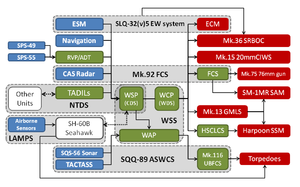- Mk 92 Guided Missile Fire Control System
-
The Mk 92 Fire Control System is a US-built medium-range anti-aircraft missile and gun fire control system. It was developed for the Oliver Hazard Perry class guided missile frigates. The system is a licensed USN version of the Thales Nederland WM-25 fire control system. The Mark 92 fire control system was approved for service use in 1975. Introduction to the fleet and follow-on test and evaluation began in 1978. In 1981, [1]
Contents
Radar Systems
The Mk 92 system assigns targets via the ship's air search radar, and surface search radar or from the MK 92's own search radar capabilities. [2]The system has two or three radar sub-systems depending on the model. The first two are combined in to a single system called the Combined Antenna System or CAS is used in all models. The CAS has a track while scan radar (Search) and a tracking radar both housed in an egg shaped randome. The radars can search for, track, and illuminate targets. There is also a third radar for target illumination referred to as the Separate Target Illumination Radar or STIR. The STIR is a radar developed from the AN/SPG-60 radar that is part of the Mk 86 gun fire control system.
Versions
- Mk 92 modification 0 is an early version of the system for the USN.
Gun and missile control: 1 air engagement channel 2 surface-search, TWS channels
- Mk 92 modification 1 is the version used by United States Coast Guard cutters. It does not use the STIR or control surface to air missiles.
Gun only: 1 air engagement channel 2 surface-search, TWS channels
- Mk 92 modification 2 is the version that was originally fit to USN Oliver Hazard Perry class guided missile frigates.
Gun and missile control: 2 air engagement channels, including STIR with Mk 107 console 2 surface-search, TWS channels
- Mk 92 modification 5 is used by certain Saudi Arabian Badr class corvettes.
Gun only: 1 air engagement channel 2 surface-search, TWS channels
- Mk 92 modification 6 is an upgraded version of the modification 2 as part of the CORT program. It was installed on 12 USN FFG-7-class frigates, the eight Republic of China Navy's Cheng Kung-class frigates and two of the Spanish Santa Maria-class units.
2 air engagement channels, including STIR with Mk 107 console and (coherent receiver/transmitter CORT) transceiver 2 surface-search, TWS channels
Modification Sufrace Engagement Channels Air Engagement Channels (gun only) Air Engagement Channels 0 2 0 1 1 2 1 0 2 2 0 2 5 2 1 0 6 2 0 2 STIR (Separate Target Illumination Radar) Deactivated
The USN retired the RIM-66E, or Standard missile-1, from active service in 2003. Oliver Hazard Perry frigates in USN service have had the STIR radar removed. The STIR radars are still in use on non-USN vessels.
References
- ^ "MK 92 Fire Control System (FCS)". GlobalSecurity.org. http://www.globalsecurity.org/military/systems/ship/systems/mk-92-fcs.htm. Retrieved 2008-12-12.
- ^ "MK 92 Fire Control System (FCS)". GlobalSecurity.org. http://www.globalsecurity.org/military/systems/ship/systems/mk-92-fcs.htm. Retrieved 2008-12-12.
- ^ "MK 92 Fire Control System Manufacturer Doc.". GlobalSecurity.org. http://www.globalsecurity.org/military/systems/ship/systems/mk92-fcs.pdf. Retrieved 2009-02-26.
See also
- Badr class corvette
- Hamilton class cutter
- RIM-66 Standard
- Oliver Hazard Perry class frigate
- Mk 74 "Tartar" Guided Missile Fire Control System
- USCG Medium Endurance Cutter
Categories:- United States Navy stubs
- Naval weapons of the United States
Wikimedia Foundation. 2010.

